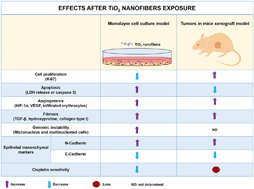Titanium dioxide nanofibers induce angiogenic markers and genomic instability in lung cells leading to a highly dedifferentiated and fibrotic tumor formation in a xenograft model
Abstract
The synthesis of novel nanofibers has increased due to their broad spectrum of applications which have raised also the concern of toxicity mediated by inhalation. Titanium dioxide (TiO2), classified as a possible carcinogen to humans by the International Agency for Research on Cancer regardless of size and shape, is being manufactured as nanofibers for waste water cleaning, extraction of enhanced miRNAs, glucose quantification and other devices. Toxicological studies of TiO2 nanofibers have shown their capability to induce sustained inflammation, frustrated phagocytosis, and lysosomal disruption, but the capability to acquire or enhance aggressive characteristics, including angiogenesis, fibrosis or epithelial mesenchymal transition (EMT) has not been investigated. In this study, we synthetized TiO2 nanofibers (anatase phase; 61.5 ± 4.9 nm width and 3.1 ± 0.2 μm length) to expose monolayers of lung epithelial cells (1 and 10 μg cm−2) for 7 days, and angiogenesis, fibrosis, EMT markers, genomic instability and cisplatin sensitivity were measured. Then, those cells were harvested and injected subcutaneously in a xenograft mouse model for tumor development. After 11 weeks, the same markers were measured in the tumors. The monolayers exposed to TiO2 nanofibers induced angiogenic, fibrotic and EMT markers, genomic instability and loss of cisplatin sensitivity. The tumors developed from exposed cells to TiO2 nanofibers were also positive for the same markers, and moreover, dedifferentiation, the remarkable presence of erythrocytes and loss of cisplatin sensitivity were higher, which suggests that TiO2 nanofibers enhance the aggressive tumor phenotype in lung epithelial cells.

- This article is part of the themed collection: Nanomaterials in air


 Please wait while we load your content...
Please wait while we load your content...